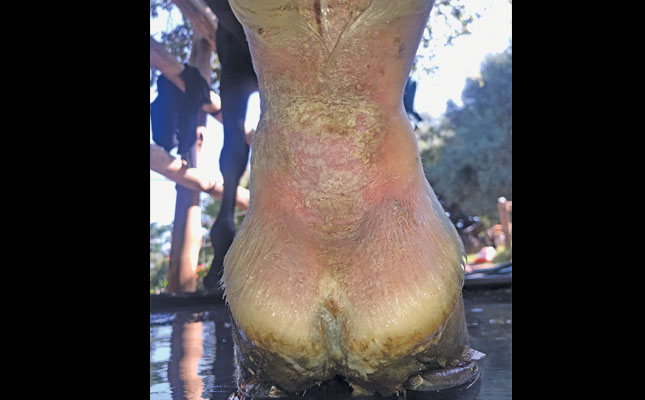
Photo: Dr Mac
Recently, due to heavy rainfall this season, horse owners and veterinarians have been seeing many cases of equine pododermatitis (‘mud fever’), an inflammation of the skin on the back of the pastern (between the fetlock and hoof).
The first signs of this condition is a reddening of the skin. The horse may also show mild lameness. Scales and scabs develop on the affected area with time.
Washing the area or rubbing in cortisone ointment may worsen the condition. It is more common in draught horses with long feathers around the hoof, as these can become very tangled, wet and muddy.
In these horses, this condition is sometimes called ‘greasy heel’. Mud fever is very common in horses with white socks and hooves, particularly on their hind legs. If untreated, the legs can swell. The lesions are also very painful to the touch, and so are often difficult to treat.
Causes
The main organism responsible for mud fever is Dermatophilus congolensis, a micro-organism that is a species of actinomycete, which is similar to both bacteria and fungi.
This organism also causes lumpy wool in sheep, which, incidentally, is also fairly common at present due to incessant rain.
It is usually found in soils contaminated by sheep, goat, horse or cow manure, and multiplies in warm, humid conditions. When there is a lot of rain and deep mud becomes caked on horses’ legs, the warmth causes the organism to start growing on the skin. This results in the reddened scaly skin seen in mud fever.
D. congolensis also happily grows on dirty, damp saddle pads and horse blankets, resulting in similar reddened, hairless, scaley lesions on the flanks and body of the horse, known as ‘rain scald’.
Prevention
If your horse is brought in from the field caked in mud, you need to wash or brush the mud off immediately. If you wash the mud off, you must dry the areas well with a towel, as damp skin promotes the growth of D. congolensis.
Damp or dirty saddle pads and blankets must be brushed, washed and dried thoroughly as well, before being used. All damp bedding in stables needs to be removed and fresh, dry straw or shavings put down. Muddy areas in paddocks can be dried out by adding a bag of clean silica sand over the problem area after it has been drained.
Treatment
To make a quick diagnosis, look for redness of the pastern if your horse is slightly lame and caked with mud. Wash off the mud using clean water, and dry the legs well with a towel.
You can rub in zinc-sulphate ointment twice or three times a day, as it tends to protect the skin and is effective against D. congolensis.
Rain scald on the body also starts with caked mud, and this should be removed and thoroughly dried. As with lumpy wool, you can spray twice a day with a 0,5% or 1% solution of zinc-sulphate.
In severe cases, contact your veterinarian. A diagnosis can be made using a skin scraping to differentiate mud fever from mange or ringworm.
Your vet can also treat your horse using intramuscular injections of penicillin, combined with either streptomycin or gentamicin for three to five days.
These antibiotics are very effective in killing the organism causing these diseases.
Dr Mac is an academic, a practising equine veterinarian, and a stud owner.










